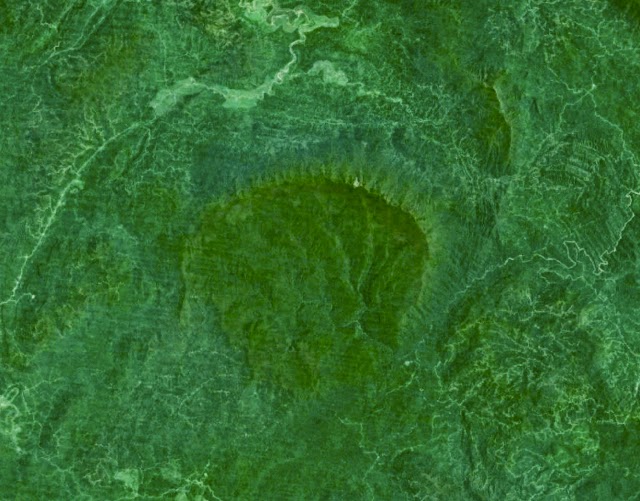____________________
Misty clouds curl around hills covered in thick jungle, Shorea and Agathis overstory trees stretch high above the canopy. Elegant raised walkways connect dining room, sleeping area, a majestic archway for visitor registration, all constructed of heavy dark-red ironwood. The doors of my room open directly to the rainforest, a symphony of unknown creatures (frog? monkey? bird?).
Then endless steep up and up to Nepenthes Camp (formerly Camel Trophy, constructed in 48 hours in 1993). I stop to take a breath every three almost-vertical steps, flicking leeches from my muddy shoes at intermittent rest stops. Sweat pours in rivers down all surfaces. Finally at the basin's rim a cool breeze caresses. The ground falls away behind trees on both sides to tantalizing glimpses of a steep drop and blue mountains. The forest changes, and our first pitcher plants sporadically appear along the path. Now in mysterious mossy woods, thick green carpets wind up tree bases like broad velvet skirts raised above waists. Bright yellow and orange fungi decorate the moss, the fancy jewelry of the forest.
Stream crossings lead--at last--to camp, perched above a treeless helipad densely covered with ferns. Others (including our speedy porters) are already there. We rest, drink more water, sit gratefully still, feel the muscles, a little ill. Dinner is always instant noodles. Can't wait to sleep, but our second level (rat poo) bunk beds fill with the toxic fumes of burning plastic from the cooking fire below. Doesn't mesh with the pristine never-logged never-lived-in wilderness of it all, but ah well, this is what happens when the convenience of plastic packaging reaches that world.
"Nepenthes paradise garden" fills the next day: more blankets of soft brilliant mossy green, white sandy soil, and the small trees of the kerangas forest. Winding vines of opulent flared golden pitchers twist around trunks. Neon hybrids with candy stripes. Red calico patches and eye-spots, diminutive hairy tentacles, hungry oval mouths. We take photos, carefully number tags, write GPS coordinates. In the dwindling light back at camp, a slender civet cat visits, eating scraps tossed into the woods.
The third day we walk to two waterfalls. Marking pitchers along the way under a misty raincloud. Our sore muscles clamber down steep cliffsides, dreading the return. Takob Akob waterfall is idyllic, perfect for a vacation postcard. We eat lunch sheltered in a shallow cave; roots hang from the ceiling above. Although it is cold, I can't miss the chance to swim through the deep pool to the crashing water's edge. Standing on the rocks next to pounding heavy water is exhilarating. The next waterfall is Dan's favorite. Flat slabs, like enormous stone steps, drop out of sight covered in thin layers of red tea water. We are on the edge of a tropical world.
Camp has a treehouse, a platform one hundred feet high. The skinny metal ladder requires multiple rest stops during ascent. We leave a handmade wooden dodecahedron covered in all of our American and Malaysian signatures, a small token of our appreciation.
The last day of fieldwork is early morning packing and then pitcher plant sampling over and over and over (taking much longer than planned) before a long, knee-breaking, slip-sliding descent back to the research center. Showering the sweat, mud, and memory of leeches off my skin is luxurious.
Dealing with samples is a long process, measuring pH, recording volume, filtering some, culturing from others, adding preservative. At midnight the generator shuts off, and I am left in the research lab in pure darkness. The last samples have to be finished with only the light of a headlamp and my ethanol burner.
The next day, we clean up, carefully pack samples, spy monkeys and giant ants along paths, and walk through beautiful tree-top canopy bridges (sponsored by Ikea). Confusion with our ride back means Dan and I get to stay one extra lovely relaxed day at the Maliau Basin.
On the drive out, we notice the paved road has expanded even closer to the conservation area's entrance during our eight days inside. The empty peacefulness of the research station may not last much longer, as the Maliau Basin becomes easier to access. I hope it is respectfully relished for the rare experience of old-growth Southeast Asian rainforest, for many generations into the future.


















































